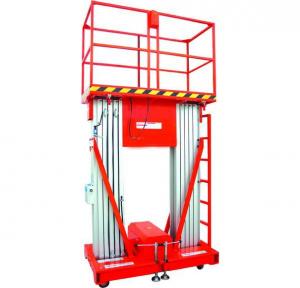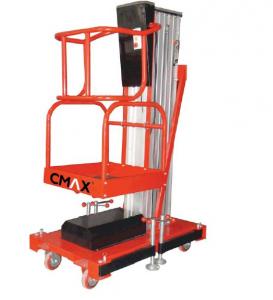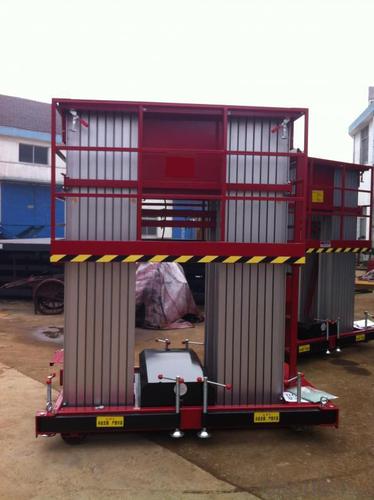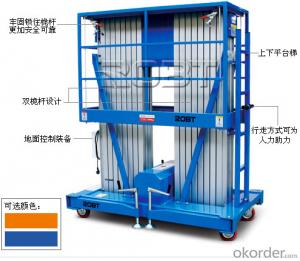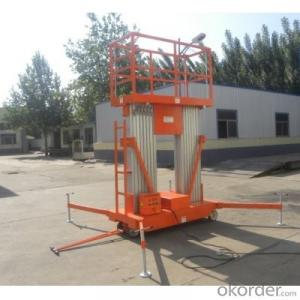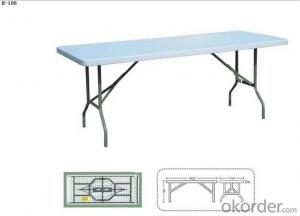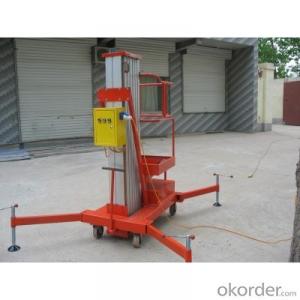Aluminium Lift
- Loading Port:
- China Main Port
- Payment Terms:
- TT or L/C
- Min Order Qty:
- -
- Supply Capability:
- 50 Sets Per Month m.t./month
OKorder Service Pledge
OKorder Financial Service
You Might Also Like
Max. working height(m): 16
Travelling when lifts(kg): 8100(12 boom)
Max. lifting torque(kN m): 2062
Boom length: 12~30(standard configuration 18m)
Aluminium Lift Working range: 4~29(outriggers extended)
Aluminium Lift elevation range: 22~77
Max. lifting height(mm): 27650 (with 30 boom)
Aluminium Lift Axle base(mm): 2650+1300
Wheel base fromt/rear(mm): 2400/2400
Aluminium Lift Ground clearance(mm):225
Gradeability(%):21
Min. turning diameter(m): 20
GVW(with 12m boom)(kg): 49700
Aluminium Lift Outigger type: H type
Machine dimension(without boom)(L×W×H)(mm): 7460× 3315× 3710
Machine dimension(with 12m boom)(L×W×H)(mm): 17150× 3315× 3710
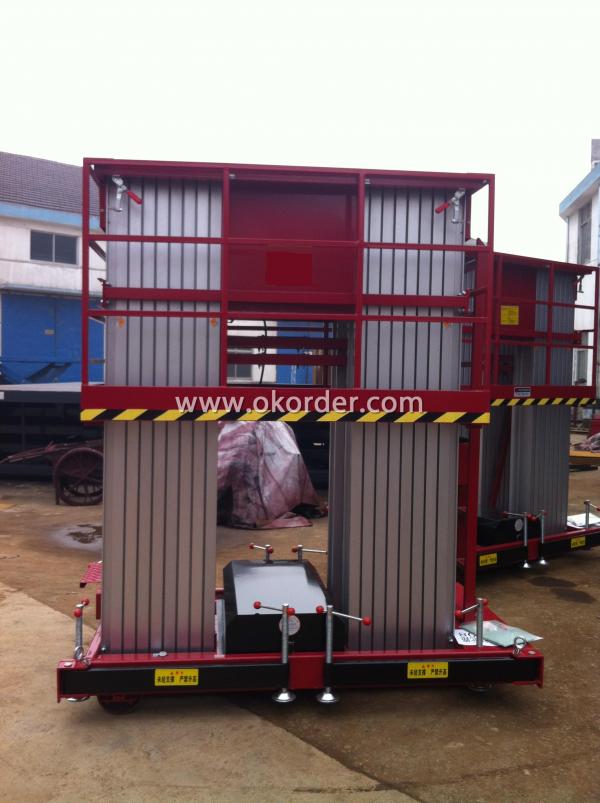
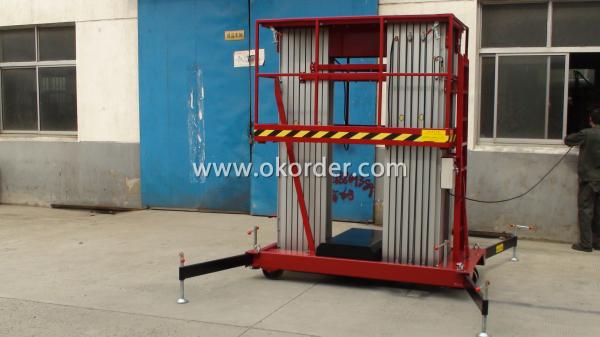
- Q: Describe the routine maintenance and inspection procedures for a building hoist.
- <p>The maintenance and inspection process for a building hoist involves several key steps to ensure safety and functionality. Regular visual inspections should be conducted to check for any visible damage or wear. Monthly inspections should include testing the emergency stop and limit switches, as well as lubricating moving parts. Quarterly inspections may involve checking the electrical connections and verifying the correct operation of safety devices. Annual inspections typically require a thorough examination by a qualified person, including testing the load-bearing capacity and ensuring all safety features are in good working order. Additionally, records of all inspections and maintenance should be kept for reference and compliance with safety regulations.</p>
- Q: What is the main function of the construction elevator safety guard
- Falling to a certain speed will automatically card death
- Q: This question asks about the process of changing the speed of a building hoist, which is a device used in construction to lift materials.
- <p>Adjusting the speed of a building hoist typically involves accessing the hoist's control panel or motor settings. For electric hoists, this may include adjusting the frequency of the power supply through a variable frequency drive (VFD), which alters the speed of the motor. For manual hoists, speed adjustments might involve changing the gear ratio or the tension on the hoisting rope. Always refer to the hoist's user manual for specific instructions, as different models have different mechanisms. Safety should be a priority; ensure that any adjustments are made by trained personnel and in compliance with safety regulations.</p>
- Q: This question asks for criteria or factors to consider when selecting the appropriate type of building hoist for a specific construction project.
- <p>Choosing a suitable type of building hoist involves considering several factors: the weight and size of materials to be lifted, the frequency of hoisting, the height of the building, and safety requirements. Assess the load capacity needed, as hoists vary in their lifting capabilities. Consider the hoist's speed and efficiency to ensure it meets the project's timeline. The hoist's size and maneuverability are crucial for fitting within the construction space. Safety features and certifications should be verified to ensure compliance with industry standards. Consulting with hoist manufacturers or rental companies can provide insights into the most suitable hoist for your specific application.</p>
- Q: Is it possible to repair or replace a hydraulic pump used in a building hoist system?
- <p>Yes, a hydraulic pump used in a building hoist can be repaired or replaced. If the pump is damaged or worn out, it can be serviced or repaired by professionals who specialize in hydraulic systems. If the damage is beyond repair, a new pump can be sourced and installed to ensure the hoist operates safely and efficiently. Regular maintenance and inspection are crucial to prevent major issues and to extend the life of the hydraulic pump.</p>
- Q: This question asks for guidelines on the safe operation of a building hoist, a device used to lift materials in construction.
- <p>To use a building hoist safely, follow these guidelines: Ensure the hoist is properly installed and inspected by a qualified person. Never exceed the hoist's weight limit. Keep the hoist area clear of obstacles and ensure all safety devices are functioning. Do not use the hoist if there are any visible defects or damage. Always secure the load properly and ensure it is balanced. Never leave the hoist unattended while in operation. Use hand signals or a communication system to coordinate with the operator. Regularly inspect and maintain the hoist to prevent accidents. Always follow the manufacturer's instructions and adhere to local safety regulations.</p>
- Q: Is it possible to use a building hoist, typically meant for construction purposes, to lift a bicycle?
- <p>While technically possible, using a building hoist to lift a bicycle is not recommended due to safety concerns. Building hoists are designed for heavy construction materials and may not be suitable for delicate items like bicycles. The risk of damage to the bicycle or injury to the operator is high. It's best to use a bicycle lift or a hand truck designed for such purposes to ensure the safety of both the bicycle and the person handling it.</p>
- Q: This question asks for the procedure or steps to operate a building hoist, which is a machine used to lift materials in construction.
- <p>To use a building hoist, first ensure it's properly installed and inspected. Familiarize yourself with its controls and safety features. Load materials evenly onto the platform, ensuring not to exceed weight limits. Activate the hoist by pressing the 'up' button to lift the materials. Maintain a safe distance while the hoist is in motion. Once at the desired floor, press the 'stop' button, then unload the materials. Always follow the manufacturer's guidelines and safety protocols to prevent accidents.</p>
- Q: Is it possible to fix or replace a building hoist once it has stopped functioning?
- <p>Yes, a building hoist can be repaired or replaced after it has failed. Repairs are often possible if the hoist has mechanical or electrical issues that can be diagnosed and fixed by a qualified technician. If the hoist is beyond repair or if it's more cost-effective, a replacement may be necessary. It's crucial to have a maintenance plan and regular inspections to prevent failures and ensure the hoist's safe operation. In case of a failure, immediate action should be taken to either repair the existing hoist or install a new one, adhering to safety standards and regulations.</p>
- Q: Is it possible for a hydraulic cylinder in a building hoist to experience leakage or failure?
- <p>Yes, a hydraulic cylinder in a building hoist can leak or break. Leaks can occur due to worn seals, damaged hoses, or corroded cylinder walls. Breakage may result from excessive pressure, manufacturing defects, or metal fatigue. Regular maintenance and inspection are crucial to detect and prevent such issues, ensuring the safety and efficiency of the hoist system.</p>
1. Manufacturer Overview
| Location | Beijing,China |
| Year Established | 2003 |
| Annual Output Value | Below US$1 Million |
| Main Markets | Mid East;Western Europe;North America |
| Company Certifications | ISO9001:2008 Certificate |
2. Manufacturer Certificates
| a) Certification Name | |
| Range | |
| Reference | |
| Validity Period |
3. Manufacturer Capability
| a) Trade Capacity | |
| Nearest Port | Shanghai |
| Export Percentage | 1% - 10% |
| No.of Employees in Trade Department | 1000 People |
| Language Spoken: | English;Chinese;Japanese |
| b) Factory Information | |
| Factory Size: | Above 300,000 square meters |
| No. of Production Lines | Above 10 |
| Contract Manufacturing | OEM Service Offered;Design Service Offered |
| Product Price Range | Average |
Send your message to us
Aluminium Lift
- Loading Port:
- China Main Port
- Payment Terms:
- TT or L/C
- Min Order Qty:
- -
- Supply Capability:
- 50 Sets Per Month m.t./month
OKorder Service Pledge
OKorder Financial Service
Similar products
Hot products
Hot Searches
Related keywords

